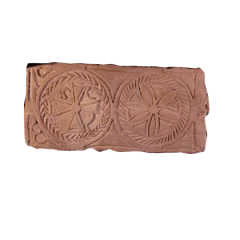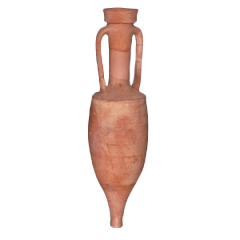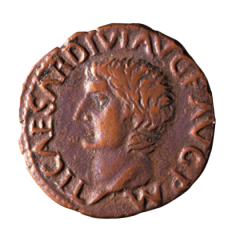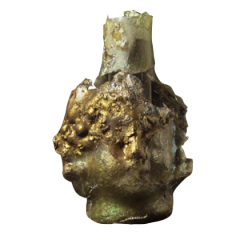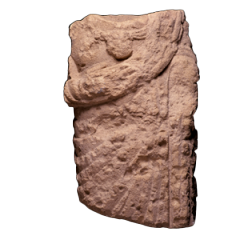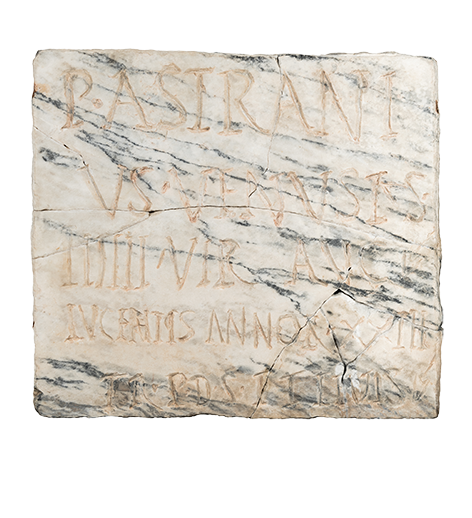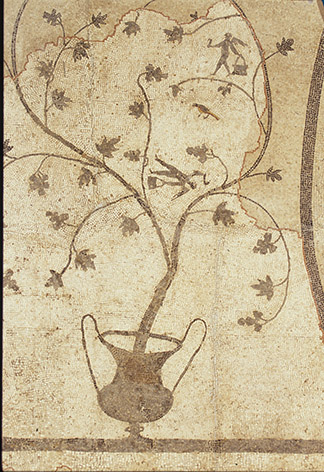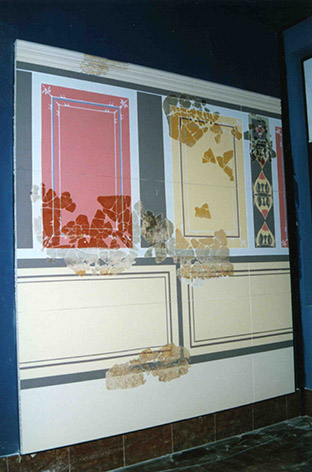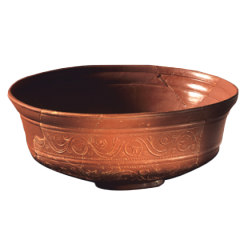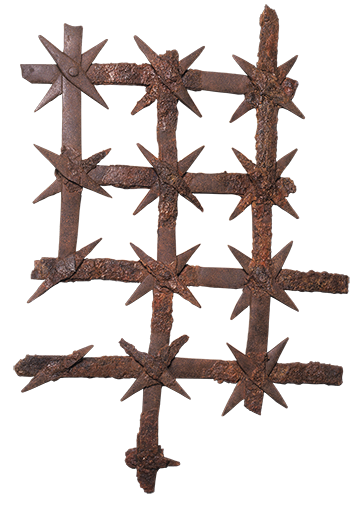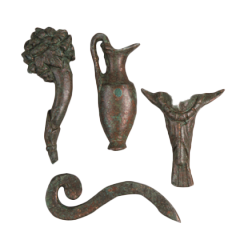
Altar lights
Lucentum, Tossal de Manises (Alicante) Bronze Plate: h: 21'5 cm; w: 5'7 cm; d: 0'3 cm Bucranea: h: 7-7'7cm; w: 6'2 cm; d: 1-1'6 cm Urceus: h: 8'7 cm ; w : 3'9 cm; e: 0'8 cm Lituus: h: 10'5 cm; a: 3'5 cm; e: 0'4 cm Cornucopia: h: 9'1cm; a: 4 cm; e: 1'5 cm Roman culture 1st century AD.
Decorated bronze plaque and appliqués of the same material of religious significance. The plate is decorated from top to bottom with a denticulate fillet, a three-lobed lesbian cyma with alternating lotus leaves and a calyx with two sepals, two petals and a pistil, and finally an astragalus. On one side, the cyme ends in an angular motif formed by a leaf with incised ribs.
The three bucranes, a cornucopia, an urceus and a lituus, as well as other fragments of similarly decorated plaques, would have been embedded in the altar itself.
They were found as a result of superficial cleaning on the eastern side of the site in the late 1970s.
The plaque and sconces would have decorated a stone altar or pedestal. The appliqués are of a liturgical nature used by Roman priests: the urceus or jug and the lituus, the curved staff of the augurs, used to delimit the celestial space in divinatory ceremonies. The skulls of oxen symbolise the animals sacrificed and carry the infulas with which they were adorned during the ritual. The cornucopia alludes to abundance, prosperity of the state and is an attribute of various deities (Fortuna, Ceres, Cybele).
There are numerous traces of these appliqués in the Roman Empire. In Hispania we can cite those of Ampurias and Ercávica (Cuenca). Ritual symbols and objects are frequently depicted on coins and stone reliefs, both in altars and architectural friezes, among which the entablature of Vespasian's temple in Rome is particularly important and beautiful.
These pieces were originally placed on a pedestal or altar in a sacred space or building, or perhaps in the forum of the Roman city of Lucentum.
C.S.: 6058
Unpublished.
Highlights Sala Cultura Romana
- ................................................. Cerro de Las Balsas (Albufereta, Alicante) Sandstone h: 97 cm; w: 46 cm; d: 12 cm h: 66 cm; w: 50 cm; d: 13 cm Roman culture 7th century AD: 46 cm; w: 12 cm h: 66 cm; h: 50 cm; w: 13 cm Roman culture 7th century AD.
- ................................................ Tossal de la Cala (Benidorm) Ceramic h:118 cm; w. 32 cm Roman culture Late 2nd - early 1st century BC: 32 cm Roman culture Late 2nd - early 1st century BC Typology Dressel 1, subtype B.
- ................................................. Isidro Albert Collection Bronze d: 2'12 cm; w: 4'7 g; d.w.:12 h Roman culture 22-23 A.D. 5th issue
- ................................................. Lucentum, Tossal de Manises (Alicante) Bronze Plate: h: 21'5 cm; w: 5'7 cm; d: 0'3 cm Bucranes: h: 7-7'7cm; w: 6'2 cm; d: 1-1'6 cm Urceus: h: 8'7 cm ; w : 3'9 cm; e: 0'8 cm Lituus: h: 10'5 cm; a: 3'5 cm; e: 0'4 cm Cornucopia: h: 9'1cm; a: 4 cm; e: 1'5 cm Roman culture 1st century AD.
- ................................................. Necropolis of El Albir (l'Alfaç del Pi) Glass h: 7'5 cm; w: 4'1 cm; d: 3'6 cm Roman culture 5th century AD: 4'1 cm; e: 3'6 cm Roman culture 5th century AD.
- ................................................. Lucentum, Tossal de Manises (Alicante) Sandstone h: 42 cm; w: 24.5 cm, d: 12 cm Roman culture Second half of the 1st century BC.
- ................................................. Lucentum (Tossal de Manises, Alicante)White marble with grey veinsh: 31.11cm; h: 28.4cm; w: 2cmRoman culture2nd century AD.
- ................................................. Baños de la Reina (Calpe, Alicante) Stone tesserae h: 264 cm; w: 288 cm Roman culture 2nd century AD.
- ................................................. Lucentum, Tossal de Manises (Alicante) Painting applied using the fresco technique on a lime mortar base. h: 305 cm; w: 265 cm h: 303 cm; w: 139 cm; d: 8 cm Roman culture First half of the 2nd century AD.
- ................................................. Lucentum (Tossal de Manises, Alicante) Ceramic h: 23.6 cm; w: 8.1 cm; d: 10.1 cm Roman culture Towards the first half of Nero's reign (50-60/65 BC).
- ................................................. Illeta dels Banyets (Alicante) Iron h: 72 cm; w: 49 cm; d: 3 cm Roman culture 2nd century AD: 49 cm; e: 3 cm Roman culture 2nd century AD.

